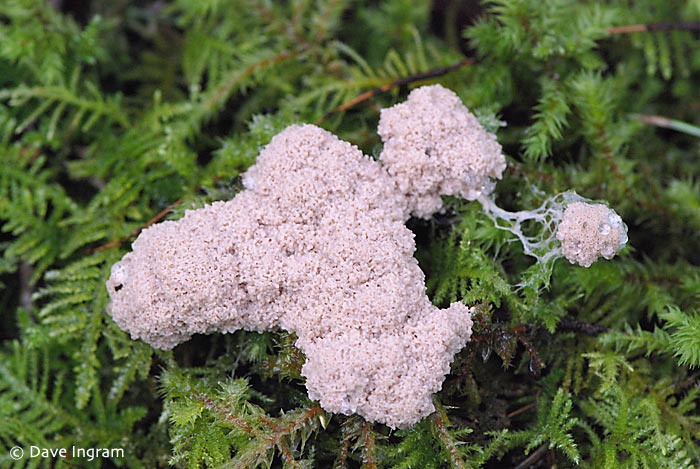At any time of year it is nice to go for a stroll in the forest and seek out some of the weird and wonderful things living there. One of the most overlooked, and interesting of these are the slime molds. Often found on rotting logs or decaying stumps, slime mold may be bright yellow like a blob of scrambled eggs, or grey-white like tapioca pudding. Despite their unattractive name, slime molds come in a wide variety of forms and colours, some of which are strangely beautiful.
What Are Slime Molds?
Scientists have long debated what slime molds are, since they have features in common with both fungi and animals. Like animals, slime molds are free-living and capable of locomotion. Like fungi, slime molds form fruiting bodies that produce reproductive units called spores.
Not fitting clearly into any category, slime molds have been placed in their own group, known as the Myxomycetes. This Greek name means myxa (slime) and mycetes (fungi). Around 700 species of myxomycetes have been described worldwide.
People who have never encountered slime molds sometimes react with fear to these unusual organisms. In Dallas, Texas in 1973, an unusually large mass of slime mold was discovered on the lawn of a suburban resident. Locals panicked, thinking that it was harmful bacteria, or an alien life form. When doused with water, the slime mold appeared to grow, which didn’t help matters. After making national news, the situation was resolved by a local science student, who identified the strange yellow blob as a slime mold. In a few days it completely disappeared.
How do Slime Molds Reproduce?
Slime mold reproduction is very complex, and begins with a single spore. Under favourable conditions the spore germinates, releasing cells that either have whip-like tails (flagellate) or no flagella (amoeboid). Whether the cells are flagellate or not depends upon moisture conditions.
These cells may act as sexual units called gametes, and will merge with compatible cells to form a zygote. The zygote then feeds and grows, and expands into a larger form called a plasmodium. During this process, the nucleus (core material of the cell) divides many times, but cells do not divide. As a result, a mature plasmodium may have thousands of nuclei, but consists of only one giant cell. This cell is bound by cell membrane or enclosed by a slime sheath. The sheath may be shed as a “slime track” behind the moving plasmodium.
Structure and Life Cycle of Slime Mold
The plasmodium usually lives in cool, dark places, where it creeps slowly forward, feeding on bacteria, yeast and bits of organic matter. Plasmodia vary in size, form and colour. Some are very small, and rarely noticed, while others are several centimeters wide. Plasmodia may be yellow, orange or red in colour, and may consist of a network of vein-like strands or be granular in appearance. During dry or cold weather the plasmodium may convert into a hard, crust like form called a sclerotium. This enables the slime mold to go dormant until conditions become favourable.
After sufficient feeding the slime mold migrates to a drier location with more light. Here, a remarkable transformation takes place. The slime mold stops feeding and moving, and the plasmodium produces a fruiting body. This transformation is brought about by certain signals such as exhaustion of available food, and changes in temperature and moisture. During this stage, the slime mold completes its life cycle by releasing spores from the fruiting body, which are dispersed by wind to new locations.
The fruiting bodies of slime molds are the phase of the life cycle most visible to humans. Fruiting bodies are found in diverse shapes and colours, and may appear as a cushion-shaped mass or a cluster of globe-shaped sporangia (spore bearing sacs) balanced on thin stalks. Fruiting bodies may also be goblet or plume shaped.
Experiments with Slime Mold
Slime molds have been used in some interesting experiments. Japanese scientists constructed a maze, and placed food at the end of two exits, with four possible routes. Surprisingly, the slime mold squeezed itself into the shortest section of maze to reach the food. Dr. Tanya Latty at the University of Sidney conducted an experiment that assessed the ability of slime molds to choose between different quality food sources with different degrees of risk. Both of these experiments may indicate that the slime mold, a single-celled organism, may possess a primitive intelligence. Another Japanese experiment tested the efficiency of slime molds in choosing food sources. The idea was that complex communication and subway systems could be modeled by the choice patterns of slime molds.
Another experiment, conducted at the University of Southampton in England, involves a slime mold plasmodium operating a small robot, known as a “slime-bot”. The legs of the robot react to the movement of the slime mold, which gravitates towards dark, hidden places.
So far, slime molds have not been known to be of medicinal value to humans, though they have been used in cellular studies connected with cancer research.
Slime molds are often encountered in the moist, shady forests of our area on decaying logs and stumps or on leaf litter of the forest floor. They may also be found on grass or bark mulch. Slime molds are harmless and delicate, so it is best to observe these mysterious organisms without disturbing them.
More information about slime molds is available in Myxomycetes: A Handbook of Slime Molds by Steven L. Stephenson.
About the Contributor:
Jocie Brooks is a naturalist and writer based in the Comox Valley, Vancouver Island, British Columbia.


